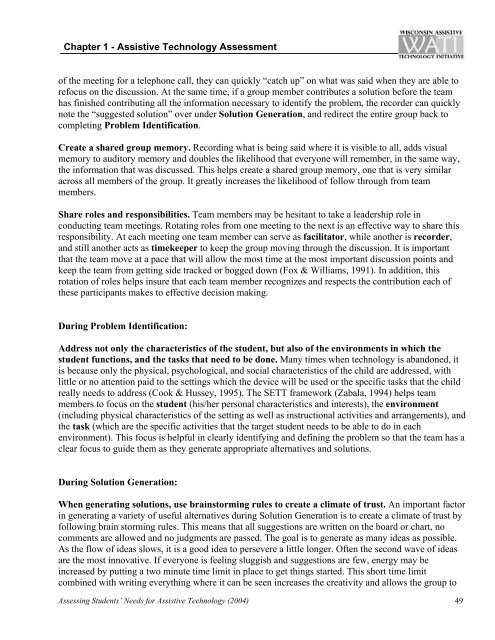Assessing Student's Needs for Assistive Technology (ASNAT)
Assessing Student's Needs for Assistive Technology (ASNAT)
Assessing Student's Needs for Assistive Technology (ASNAT)
Create successful ePaper yourself
Turn your PDF publications into a flip-book with our unique Google optimized e-Paper software.
Chapter 1 - <strong>Assistive</strong> <strong>Technology</strong> Assessment<br />
of the meeting <strong>for</strong> a telephone call, they can quickly “catch up” on what was said when they are able to<br />
refocus on the discussion. At the same time, if a group member contributes a solution be<strong>for</strong>e the team<br />
has finished contributing all the in<strong>for</strong>mation necessary to identify the problem, the recorder can quickly<br />
note the “suggested solution” over under Solution Generation, and redirect the entire group back to<br />
completing Problem Identification.<br />
Create a shared group memory. Recording what is being said where it is visible to all, adds visual<br />
memory to auditory memory and doubles the likelihood that everyone will remember, in the same way,<br />
the in<strong>for</strong>mation that was discussed. This helps create a shared group memory, one that is very similar<br />
across all members of the group. It greatly increases the likelihood of follow through from team<br />
members.<br />
Share roles and responsibilities. Team members may be hesitant to take a leadership role in<br />
conducting team meetings. Rotating roles from one meeting to the next is an effective way to share this<br />
responsibility. At each meeting one team member can serve as facilitator, while another is recorder,<br />
and still another acts as timekeeper to keep the group moving through the discussion. It is important<br />
that the team move at a pace that will allow the most time at the most important discussion points and<br />
keep the team from getting side tracked or bogged down (Fox & Williams, 1991). In addition, this<br />
rotation of roles helps insure that each team member recognizes and respects the contribution each of<br />
these participants makes to effective decision making.<br />
During Problem Identification:<br />
Address not only the characteristics of the student, but also of the environments in which the<br />
student functions, and the tasks that need to be done. Many times when technology is abandoned, it<br />
is because only the physical, psychological, and social characteristics of the child are addressed, with<br />
little or no attention paid to the settings which the device will be used or the specific tasks that the child<br />
really needs to address (Cook & Hussey, 1995). The SETT framework (Zabala, 1994) helps team<br />
members to focus on the student (his/her personal characteristics and interests), the environment<br />
(including physical characteristics of the setting as well as instructional activities and arrangements), and<br />
the task (which are the specific activities that the target student needs to be able to do in each<br />
environment). This focus is helpful in clearly identifying and defining the problem so that the team has a<br />
clear focus to guide them as they generate appropriate alternatives and solutions.<br />
During Solution Generation:<br />
When generating solutions, use brainstorming rules to create a climate of trust. An important factor<br />
in generating a variety of useful alternatives during Solution Generation is to create a climate of trust by<br />
following brain storming rules. This means that all suggestions are written on the board or chart, no<br />
comments are allowed and no judgments are passed. The goal is to generate as many ideas as possible.<br />
As the flow of ideas slows, it is a good idea to persevere a little longer. Often the second wave of ideas<br />
are the most innovative. If everyone is feeling sluggish and suggestions are few, energy may be<br />
increased by putting a two minute time limit in place to get things started. This short time limit<br />
combined with writing everything where it can be seen increases the creativity and allows the group to<br />
<strong>Assessing</strong> Students’ <strong>Needs</strong> <strong>for</strong> <strong>Assistive</strong> <strong>Technology</strong> (2004) 49











